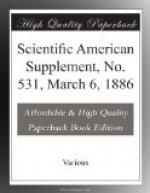4.21 x 100 4.21 : 6.72, or ------------ = 52 per cent. 72
Mr. B.D. Healey, Assoc. M. Inst. C.E., and the author are just now constructing large experimental plant in which water gas will be used as the reducing agent. This plant would have been at work before this but for some defects in the valvular arrangements, which will be entirely removed in the new modifications of the plant.
* * * * *
ANTISEPTIC MOUTH WASH.
Where an antiseptic mouth wash is needed, Mr. Sewill prescribes the use of perchloride of mercury in the following form: One grain of the perchloride and 1 grain of chloride of ammonium to be dissolved in 1 oz. of eau de Cologne or tincture of lemons, and a teaspoonful of the solution to be mixed with two-thirds of a wineglassful of water, making a proportion of about 1 of perchloride in 5,000 parts.—Chemist and Druggist.
* * * * *
ANNATTO.
[Footnote: Read at an evening meeting of the North British Branch of the Pharmaceutical Society, January 21.]
By WILLIAM LAWSON.
The subject which I have the honor to bring shortly before your notice this evening is one that formed the basis of some instructive remarks by Dr. Redwood in November, 1855, and also of a paper by Dr. Hassall, read before the Society in London in January, 1856, which latter gave rise to an animated discussion. The work detailed below was well in hand when Mr. MacEwan drew my attention to these and kindly supplied me with the volume containing reports of them. Unfortunately, they deal principally with the adulterations, while I was more particularly desirous to learn the composition in a general way, and especially the percentage of coloring resin, the important constituent in commercial annatto. Within the last few years it was one of the articles in considerable demand in this part of the country; now it is seldom inquired for. This, certainly, is not because butter coloring has ceased to be employed, and hence the reason for regretting that the percentage of resin was not dealt with in the articles referred to, so that a comparison could have been made between the commercial annatto of that period and that which exists now. In case some may not be in possession of literature bearing on it—which, by the way, is very meager—it may not be out of place to quote some short details as to its source, the processes for obtaining it, the composition of the raw material, and then the method followed in the present inquiry will be given, together with the results of the examination of ten samples; and though the subject doubtless has more interest for the country than for the town druggist, still, I trust it will have points of interest for both.




